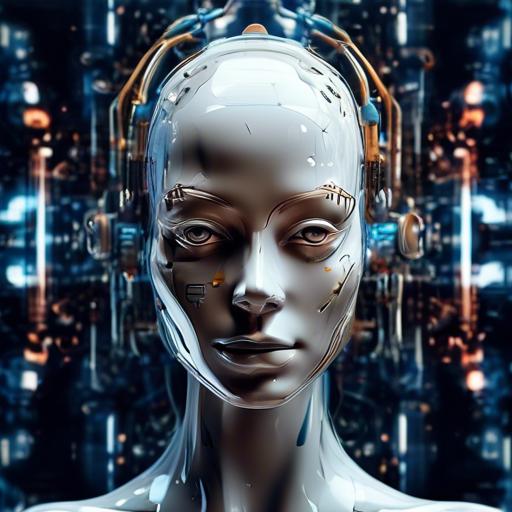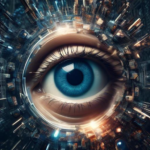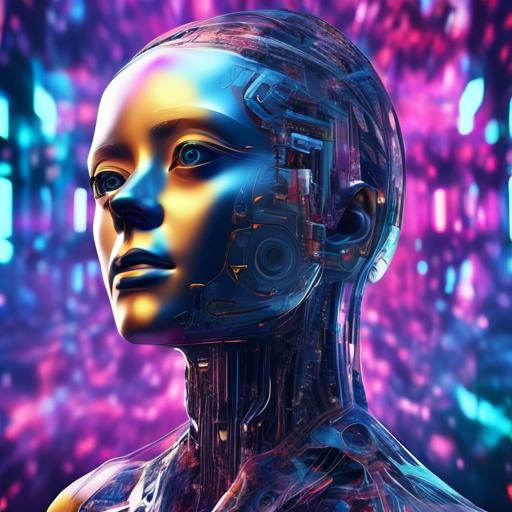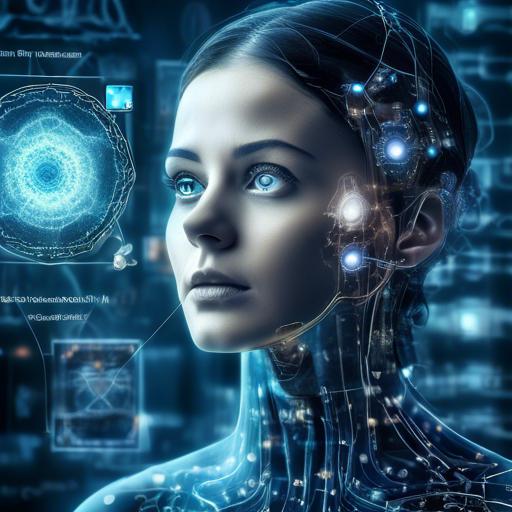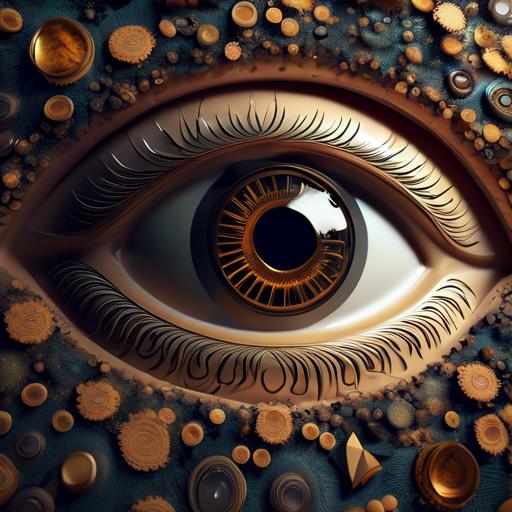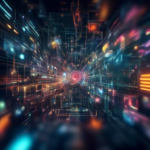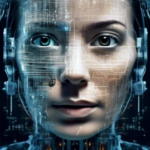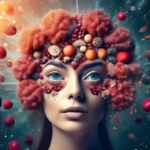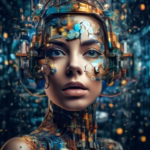In a world where creativity knows no bounds and artistry is constantly redefined, the fusion of artificial intelligence and visual storytelling has birthed an unprecedented marvel: AI-generated portraits and characters. Imagine a brush that learns from centuries of artistic prowess, a chisel that carves out human likeness infused with emotions, or a pixel that pulses with the essence of individuality. This is not the realm of mere imagination but the pioneering frontier of AI technology.
From the delicate curls of a meticulously painted Renaissance figure to the bold lines of a comic book hero, AI techniques are revolutionizing how we perceive and produce portraits and characters. Whether you’re an aspiring artist, an author in need of visual companions for your narrative, or a game designer seeking to breathe life into your virtual worlds, artificial intelligence is here to enhance your creative journey.
This article delves into the mesmerizing techniques behind AI-generated artistry, unraveling the labyrinth of algorithms and neural networks that craft these digital marvels. We aim to guide you through the tapestry of innovation, offering you the tools and knowledge to weave your artistic visions into reality. Embrace the symbiosis of human ingenuity and machine learning, as we embark on a journey where every pixel tells a story and every character is a masterpiece in the making. Welcome to the future of creativity.
Table of Contents
- Understanding the Evolution of AI in Portrait and Character Generation
- Exploring Generative Adversarial Networks for Realistic Portraits
- Harnessing Variational Autoencoders for Artistic Character Creation
- Dive into Neural Style Transfer: Blending Art and AI
- The Role of Deep Reinforcement Learning in Character Design
- How Transfer Learning Enhances AI-Powered Portraits
- Optimizing Human-AI Collaboration in Character Design
- Ensuring Ethical Practices in AI-Generated Personalities
- Future Trends in AI-Driven Portrait and Character Generation
- Concluding Remarks
Understanding the Evolution of AI in Portrait and Character Generation
The journey of artificial intelligence in portrait and character generation has been nothing short of fascinating. Initially, AI techniques were fairly rudimentary, focusing primarily on procedural generation which relied on a set of predefined rules to create variations. However, with the advent of **deep learning** and **neural networks**, the possibilities expanded exponentially.
In its early stages, AI could perform basic image stitching and simple morphing techniques. This changed dramatically with the introduction of Convolutional Neural Networks (CNNs). CNNs empowered AIs to understand and generate visual data with unprecedented accuracy, enabling more realistic and dynamic character portraits. It is this technology that forms the basis of many modern AI-driven art and photo editing applications.
- **Procedural Generation**: Early methods based on rules and logic.
- **Convolutional Neural Networks**: Enhanced understanding and generation of images.
- **Generative Adversarial Networks (GANs)**: Introduced to create high-quality, realistic images.
The introduction of **Generative Adversarial Networks (GANs)** revolutionized the field even further. Unlike previous models, GANs consist of two neural networks—the generator and the discriminator—that compete against each other. This adversarial process helps refine the generated images to a level of detail and realism previously unattainable. Current GANs can produce stunningly accurate human faces that are almost indistinguishable from real photographs.
| Method | Capabilities |
|---|---|
| Procedural Generation | Rule-based, limited detail |
| CNNs | Enhanced visual understanding |
| GANs | High-quality, realistic images |
Further advancements include **StyleGAN**, a variant of GANs that allows for intricate control over visual style and features. This technique makes it possible to tweak specific attributes such as hair color, facial expression, or even age, giving artists and designers unprecedented flexibility and creative control.
These technological strides have expanded the horizons of what is possible in digital art and character creation. They not only save time but also open new avenues for creativity and personalization, allowing artists to seamlessly blend their unique styles with AI-generated elements.
Exploring Generative Adversarial Networks for Realistic Portraits
Generative Adversarial Networks (GANs) are revolutionizing the way we create and interact with portraits. By harnessing the power of two neural networks—one creating and one critiquing—the technology steadily improves the quality of generated images until they become remarkably lifelike. GANs specifically excel in producing portraits that captivate with their realism and detail, making them ideal for artistic ventures, social media, and even personalized avatars in gaming environments.
Key components making GANs proficient in generating realistic portraits include:
- Generator: Responsible for creating data samples that resemble the original dataset.
- Discriminator: A neural network that evaluates and critiques the generated data samples.
- Adversarial Training: The process where the generator improves its output based on feedback from the discriminator.
A specific type of GAN, known as StyleGAN, has set new standards for photorealism in portraits. By manipulating latent variables, StyleGAN enables the generation of high-resolution, highly detailed images that can be customized for specific attributes like **age**, **gender**, and **facial expressions**.
Here’s a quick comparison of traditional image generation methods versus GAN-based approaches:
| Method | Quality | Customization | Scalability |
|---|---|---|---|
| Traditional Image Editing | Medium | Low | Limited |
| Basic Neural Networks | High | Moderate | Moderate |
| GANs (e.g., StyleGAN) | Very High | High | High |
The application of GANs goes beyond just creating beautiful portraits; they offer a myriad of creative possibilities:
- Art Remastering: Recreating and enhancing classic art pieces to modern standards.
- Virtual Avatars: Personalized, lifelike avatars for virtual reality and gaming.
- Advertising: Generating compelling and highly targeted advertisement visuals.
Delving into the realm of GANs for realistic portraits not only pushes the boundaries of digital art but also democratizes creativity by making high-quality tools accessible to everyone. Whether you are an artist, a game developer, or just someone curious about AI, the potential to innovate and create is now at your fingertips.
Harnessing Variational Autoencoders for Artistic Character Creation
Variational Autoencoders (VAEs) have taken the world of artistic character creation by storm, offering a novel way to blend creativity with technology. These advanced AI models enable the generation of unique portraits and characters by capturing the underlying patterns within large datasets of images. By leveraging the power of VAEs, artists and developers can create characters that are not only visually appealing but also imbued with distinctive styles and traits.
A standout feature of VAEs is their ability to generate a **latent space**—a compressed representation of the input data. Within this space, different points correspond to different character features, allowing for seamless interpolation between various styles. This opens up endless possibilities for artists to explore creative transformations:
- **Style blending**: Mix and match artistic styles to produce hybrid characters.
- **Morphing**: Seamlessly transition between different character expressions and features.
- **Customizability**: Add unique attributes to characters by manipulating their latent representations.
Collaborative projects become even more immersive, thanks to VAEs. Artists, designers, and developers can collectively experiment with the model by tweaking dimensions within the latent space, effectively co-creating visionary art pieces. Moreover, this AI-driven approach democratizes character creation, making it accessible to those with limited traditional artistic skills but who possess a flair for innovation.
| Attribute | VAEs in Art |
|---|---|
| Latent Space | Transforms features |
| Customization | Endless possibilities |
| Collaboration | Interactive & immersive |
Despite their advanced capabilities, VAEs are designed to be user-friendly. Various open-source libraries and pre-trained models are available for enthusiasts to start their artistic adventure. With a basic understanding of machine learning concepts, anyone can dive into the world of VAEs, pushing the boundaries of character creation and expression. This seamless integration of AI in art ensures that the future holds even more innovative and exhilarating artistic endeavors.
Dive into Neural Style Transfer: Blending Art and AI
Imagine blending the vivid colors of Van Gogh with the serene landscapes of Monet or altering a photo to resemble a Picasso masterpiece. **Neural Style Transfer (NST)** makes this possible by leveraging the power of Convolutional Neural Networks (CNNs) to merge the artistic style of one image with the content of another. Not just for generating unique artwork, NST is also transforming how we perceive portrait and character creation in digital art.
NST operates by decoupling the style and content of images through a dual-loss function; one part preserves the content’s structural integrity, while the other ensures the style’s distinctive brushstrokes and hues are accurately replicated. **Applications in portraiture and character design include**:
– Creating unique, artistic renditions of photographs
– Developing stylized avatars for gaming and virtual worlds
- Enhancing storybook illustrations and graphic novels
| Mode | Use Case |
|---|---|
| Photo-Realistic | Realistic yet stylized representations |
| Abstract | Vibrant, interpretative designs |
| Fantasy | Imaginary and surreal character creation |
To get started with NST, software like **DeepArt** or frameworks like **TensorFlow** and **PyTorch** can be used. These platforms offer pre-trained models that can be fine-tuned to different artistic styles. For beginners, there are ample tutorials and community forums to help you navigate the complexities and nuances of the style transfer process.
While NST may seem daunting at first, the key is to practice and experiment. Don’t hesitate to try different combinations and styles until you find what resonates with your creative vision. After all, the real magic happens in the intersection of technique and imagination.
The Role of Deep Reinforcement Learning in Character Design
Deep reinforcement learning (DRL) has revolutionized numerous fields, and character design is no exception. By harnessing the power of neural networks, designers can create intricate, dynamic portraits and characters that are not only visually stunning but also deeply complex. This advanced AI technique allows for more intuitive character behaviors, adapting in real-time to interactions and narrative progressions.
- Adaptive Learning: Characters can evolve based on player interactions, leading to a more personalized gaming experience.
- Enhanced Realism: Minutely detailed facial expressions and realistic movement patterns create a more immersive environment.
- Autonomous Character Development: Characters can independently develop relationships and skills, making the narrative richer.
Deep reinforcement learning enables characters to act autonomously in complex environments, emulating human-like decision-making processes. For instance, in a virtual world, each character can navigate, interact, and adapt their behavior according to the unfolding story. Incorporating DRL into character design allows for smarter NPCs (non-player characters), reducing the need for pre-scripted actions and responses.
| Feature | Benefit |
|---|---|
| Real-time Adaptation | Characters learn from interactions, providing unique experiences. |
| Predictive Behavior | Anticipates player moves and adapts accordingly, enriching gameplay. |
Using deep reinforcement learning, designers can also introduce ethical decision-making into characters. This means characters can make morally complex decisions, affecting the storyline in significant ways. When a player’s actions influence a character’s moral compass, it adds layers of depth and consequence to the gaming experience.
Ultimately, the integration of DRL in character design paves the way for an astonishingly immersive and interactive experience, making fictional worlds more vivid and engaging than ever before. As technology advances, the potential for creating lifelike, evolving characters continues to grow, bringing a new dimension to storytelling and interactive design.
How Transfer Learning Enhances AI-Powered Portraits
**Transfer Learning** is a groundbreaking technique that’s significantly enhancing the realm of AI-powered portraits. This approach allows pre-trained models, often developed for a general purpose, to be fine-tuned for more specific applications like generating highly detailed and stylistic portraits. The core advantage is the reduced computational resources and training time, enabling even smaller teams to achieve professional-quality results.
One of the profound benefits of transfer learning is that it builds upon an already formed knowledge base. By leveraging models pre-trained on massive datasets, AI systems can recognize intricate patterns and features inherent in human faces. Such competencies can then be specialized further to understand and generate unique artistic styles. **Key benefits include:**
- Lower training data requirements
- Reduced computational costs
- Rapid deployment of new models
Consider how this translates into practice. A model initially trained to recognize objects in a general image dataset can be fine-tuned with a comparatively smaller, more focused dataset of human faces. This refinement allows the model to integrate a rich understanding of diverse portrait styles. **For instance**, an AI artist can achieve distinct styles such as impressionism, realism, or abstract art more efficiently.
| Style | Benefits |
|---|---|
| Impressionism | Soft, dream-like representation |
| Realism | Accurate and detailed portrayal |
| Abstract | Creative and unique designs |
A practical example of transfer learning in action is the use of Generative Adversarial Networks (GANs). By fine-tuning GANs pre-trained on millions of images, creators can produce stunningly realistic and artistically rich portraits without starting from scratch. This not only expedites the creative process but also democratizes the technology, making high-quality AI tools accessible to digital artists around the world.
Ultimately, transfer learning empowers AI to keep evolving by building on established foundations. By continually refining and expanding existing knowledge, AI becomes an ever-more effective partner in artistic endeavors, ushering in a new age of creativity and efficiency in digital art and character generation.
Optimizing Human-AI Collaboration in Character Design
In the evolving world of digital artistry, optimizing the collaboration between human artists and AI technologies has become paramount, especially when it comes to character design. By leveraging advanced AI techniques, artists can push the boundaries of creativity and efficiency, creating truly dynamic characters and portrait designs.
**Key AI Techniques in Character Design**:
- Generative Adversarial Networks (GANs): These networks pit two neural networks against each other to generate new images. GANs are invaluable in creating unique character features, designs, and even realistic textures.
- Neural Style Transfer: This technique can apply the style of one image to another, allowing artists to imbue their characters with various artistic styles quickly.
- Autoencoders: By encoding and decoding images, autoencoders help in refining character designs and making complex modifications efficiently.
**Benefits of Human-AI Collaboration**:
- Speed and Efficiency: AI can quickly generate multiple character concepts, letting human artists focus on fine-tuning and adding personal touches.
- Enhanced Creativity: AI can present unconventional design ideas that artists might not have considered, sparking innovative approaches.
- Consistency: AI tools can maintain design consistency across different characters and portraits, essential in creating cohesive visual universes.
| Technique | Benefit | Use Case |
|---|---|---|
| GANs | Generate unique features | Character creation |
| Neural Style Transfer | Apply artistic styles | Portrait enhancements |
| Autoencoders | Refine designs | Complex modifications |
Effective human-AI collaboration not only enhances the quality of the character designs but also allows for more innovative and visually appealing outcomes. By harnessing AI’s capabilities while preserving the intuitive and emotional insights of human creators, this synergy can set new standards in the art of character design.
Ensuring Ethical Practices in AI-Generated Personalities
Developing AI-generated personalities requires careful consideration of ethical practices. Ensuring these creations reflect a broad spectrum of humanity without fostering negative stereotypes or biases is paramount. Here are some crucial steps to uphold ethical standards:
- Diverse Data Sets: Use varied and comprehensive data to train AI, covering multiple demographics to avoid narrow or biased portrayals.
- Transparency: Clearly indicate when content or personalities are AI-generated to maintain trust.
- Consent and Privacy: Respect user consent and privacy, ensuring any personal data used in training is adequately anonymized.
Ethics in AI-generated personalities isn’t just about data; it’s also about design and implementation. Ensure that the AI’s decision-making processes can be audited and understood by stakeholders.
| Challenges | Solutions |
|---|---|
| Bias in Training Data | Diverse and Inclusive Data Sets |
| Transparency Issues | Clear Disclosure of AI Usage |
| Privacy Concerns | Data Anonymization |
Developers play a crucial role in this ecosystem. They must regularly update and refine algorithms to adapt to societal changes and ensure accuracy. Continuous learning and adaptation help AI systems become more resilient and less prone to ethical oversights.
Moreover, involving ethicists, sociologists, and diverse user groups in the development process can provide valuable perspectives, pointing out potential ethical pitfalls before they become problematic. Collaboration across disciplines fosters a more comprehensive and sensitive approach to creating AI-generated characters, ultimately contributing to a fairer and more inclusive digital world.
Future Trends in AI-Driven Portrait and Character Generation
The realm of AI-driven portrait and character generation is rapidly evolving, with multiple future trends expected to revolutionize this creative field. One significant trend is the increased **personalization** capabilities of AI models. As technology advances, these systems will be able to generate highly customized portraits and characters that closely align with individual artistic visions and specific project requirements. Imagine AI algorithms that could intuitively grasp an artist’s unique style and preferences, crafting characters that perfectly match the desired aesthetics and thematic elements.
Another exciting trend is the integration of **multi-modal AI systems**, combining visual and textual data to enhance character and portrait generation. By utilizing insights from written descriptions, these advanced models can produce more detailed and contextually appropriate images. This capability allows for the creation of characters that are not only visually striking but also rich in narrative depth. Through the synthesis of multiple data sources, artists and developers will be empowered to bring their creative visions to life with greater accuracy and emotional resonance.
Furthermore, there is growing interest in **ethical AI** and the importance of ensuring diversity and representation in character generation. Future AI systems will likely incorporate more sophisticated algorithms to avoid biases and promote inclusivity. These AI models will be trained on diverse datasets that better represent various cultures, identities, and aesthetics, leading to the creation of characters that reflect a wider array of human experiences. This shift towards ethical AI will support creators in their efforts to develop more representative and socially conscious art.
- Increased personalization capabilities
- Integration of multi-modal AI systems
- Focus on ethical AI and diversity
Another trend to watch out for is the development of **real-time character generation** tools. With advancements in computational power and algorithm efficiency, artists will soon be able to create complex characters in real time, drastically reducing the time and effort required for character design. Such tools will be particularly useful in fields like gaming and virtual production, where quick iteration and adaptability are paramount. Real-time generation will also open new possibilities for interactive and collaborative creative processes, where artists can experiment and refine their designs on the fly.
Moreover, growing collaborations between AI developers and artists are likely to foster innovation in **hybrid creative workflows**. By combining the strengths of AI’s analytical power with human creativity and intuition, these partnerships will lead to the emergence of novel art forms and techniques. Artists will benefit from AI tools that can handle repetitive tasks, provide inspiration, or suggest new directions, freeing them to focus on higher-level creative decisions and exploration.
| Future Trend | Key Benefit |
|---|---|
| Personalization | Tailored character designs |
| Multi-modal AI | Enhanced narrative depth |
| Ethical AI | Diverse representation |
| Real-time Tools | Faster design processes |
| Hybrid Workflows | Innovative art forms |
Concluding Remarks
the use of AI techniques for generating portraits and characters opens up a world of possibilities for artists and creators alike. With advancements in technology, the potential for creating unique and captivating pieces of art is endless. So whether you are a seasoned artist looking to expand your creativity or a newcomer eager to explore new artistic horizons, AI can be a valuable tool to enhance your work. Embrace the power of AI and let your imagination run wild as you bring your characters and portraits to life. The future of art is bright, and with AI by your side, the possibilities are truly infinite. Let your creativity soar and watch as your creations come to life in ways you never thought possible. The journey ahead is filled with excitement and endless potential, so embrace the power of AI and unleash your artistic genius. The world is waiting to see what you create.






